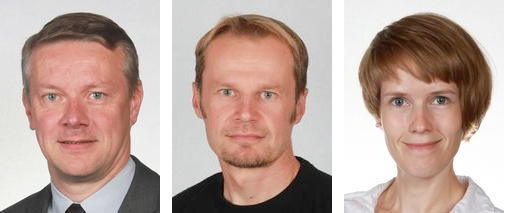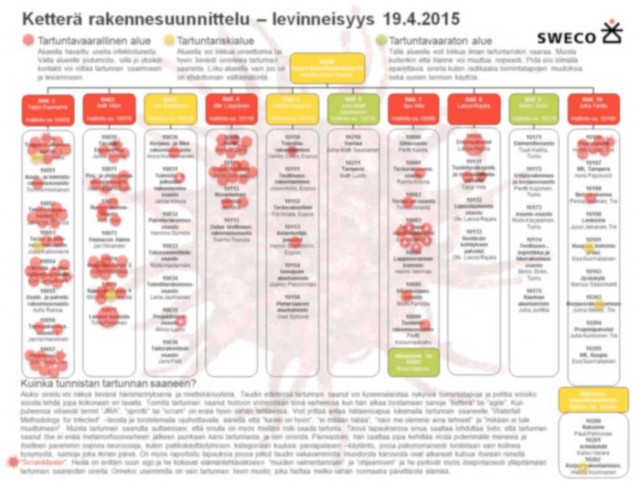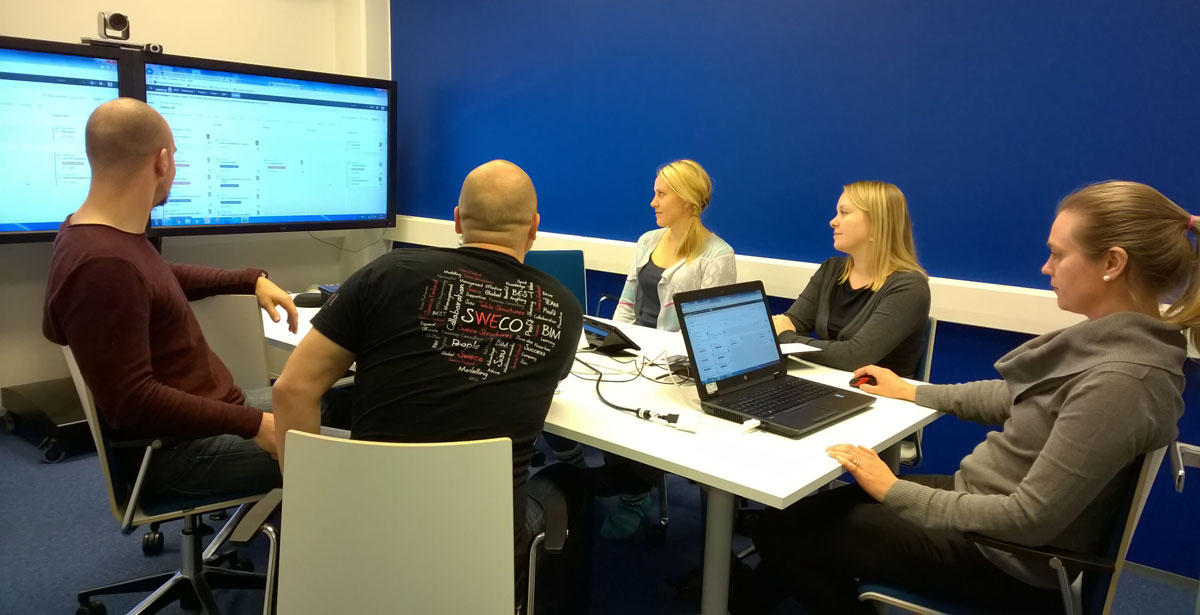What happened when an enthusiastic engineer brought scrum – an agile IT project-management framework – to Sweco Finland? A lot of good things, as my interview reveals.
Sweco Finland is part of the international Sweco Group, Europe’s leading architecture and engineering consultancy. They have over 14,500 employees, 2,000 of whom live in Finland. I had the privilege of interviewing CEO Ismo Tawast, CTO Timo Pekkinen and Structural Engineer (B.Sc.) Niina Jaatinen of Sweco Structures in Finland on their new, agile way of managing engineering design.
 Ismo Tawast, Timo Pekkinen and Niina Jaatinen
Ismo Tawast, Timo Pekkinen and Niina JaatinenSweco stands out with development
Ismo Tawast thinks that a strong commitment to development has made Sweco Finland successful: “We have invested, systematically over the years, in the development of know-how, design methodologies, and technologies, both internally and for the clients.” According to Timo Pekkinen, “Building information modeling is a foundation of our design, and we’ve been in the BIM forefront in Finland.”
In engineering, as in all professional services, final success comes from the people. Sweco employs savvy engineers who can adjust their behavior when change is due.
Why engineering project management needs rethinking
“One of the biggest challenges in a modern construction project are the huge amount of information exchanged and the number of people involved in the process,” says Ismo Tawast. “We can have over 100 structural engineers alone on one large project. We don’t have a problem in finding the best talent for a project, we have a problem in managing all the information and interactions between the participants,” he continues.
“Each of our projects is unique,” says Niina Jaatinen. “We cannot implement lean methodologies in a similar way that e.g. Toyota has done in their car production. We’ve naturally tried to eliminate waste in our processes according to lean principles. Specifications change as we move along. It is not always clear for the client what the final requirements will be. Engineering design is an iterative process, which makes accurate long-term planning impractical.”
How scrum sneaked into Sweco
Niina has been responsible for quality development for two years. The management team mandated her to improve the way engineering was done in the company.
“I noticed how we were unable to efficiently manage the ever-increasing amount of changes that occur in every construction project. We followed a rigid waterfall project model, even though many engineers did not realize that,” Niina recalls.
While considering different methodologies and techniques, she learned about scrum, an agile project management framework widely used in IT development. “I was immediately fascinated by scrum and realized it was something that we could use in our hectic design projects,” says Niina. She especially liked the idea of open communication and the active role of the client in the process. That proved to be a pivotal discovery.
Niina started off her scrum project, Sweco@agile, surreptitiously. Her strategy was to bypass the top management level and go straight into prototyping on actual projects. She handpicked a group of project managers and project engineers and presented her idea, the scrum model, and the tools that they would use. She convinced ten project managers to start testing scrum. Niina had decided not to start with sticky notes and whiteboards; instead, she chose Atlassian JIRA Agile and Atlassian Confluence for open communication and decision-making.
At first, the software tools were in the cloud, and Niina was able to modify them according to users’ requests. Later on, she had the tools installed on a Sweco server, but unfortunately the server was not able to handle all the traffic. That was how her clandestine operation was finally uncovered. At the time, there were already many scrum users and their experiences had been overwhelmingly positive.
“At first I was scolded for my unauthorized project. Then I was praised for the results,” Niina says. She continues, “I had sneakily managed to undertake a substantial change and encouraged a group of hesitant engineers to try out something completely different.”
The agile infection spread fast
After the official approval, scrum started to take off at Sweco Structures. After 12 months of use, there are now about 50 agile projects in production with 400 users in Sweco and 60 clients or other external users. The software tools currently run on five servers.
“In November 2014, we had a meeting with profit center leaders. After a presentation of Sweco@agile my first reaction was that this is the silver bullet!” Ismo says. “We decided not to force this solution on anybody, but it took off without any push from above. Niina started to report every month with ‘an infection map’ of how the ‘agile virus’ is spreading in the organization,” Ismo chuckles. Today, eight out of ten profit centers are using the agile project management model.

 Agile “Virus Map” – Sweco
Agile “Virus Map” – SwecoAgile Structural Engineering in a nutshell
Niina created Agile Structural Engineering by using the principles of scrum. Design teams have weeklong sprints, planning and review meetings, daily scrums, and 15 Sweco scrum masters.
A sprint is the basic unit of an agile project. It is a time-limited iteration for the sprint team to achieve a certain goal. Each sprint starts with a planning event that aims to define a sprint backlog, identify the work for the sprint, and make an estimated commitment for the sprint goal. The backlog comprises an ordered list of requirements that a scrum team maintains for a project. On every day of a sprint, the team holds a short daily scrum to review advancement and identify any obstacles that would prevent them from achieving the goal.
A sprint ends with a sprint review and retrospective that reviews progress to show to stakeholders and to identify lessons and improvements for the next sprints.
Project teams can choose if they want to implement scrum. Niina gives a short introduction to the team, telling them the basics of agile project management and showing them the tools, and then points out the benefits that scrum users can receive. Teams are free to adapt scrum in a way that fits their project’s needs.
At the same workshop, the project manager creates the first task list. After one or two days, the whole team starts using JIRA and team members add their own tasks. After only 30 minutes you get a realistic picture of what’s going on in a project. The first sprint is complete in a week.
In addition to JIRA – the tool for task and backlog management – Sweco teams use Confluence as a project forum and a channel for distributing project management documents. It is, in a way, an internal social media platform. Clients also have access to these platforms. In fact, clients also have tasks to complete, which are monitored in the same manner as internal tasks.
“Niina has been able to modify the tools to our liking. I feel that we are only limited by our imagination when it comes to collaboration tools,” says Timo. Using Confluence, he and Niina recently collected ideas from 700 people on how to develop the way they work.
- JIRA and Confluence screenshots (click to expand) – Sweco Structures
Benefits so far
“One of the big positive changes has been openness. The client’s project manager is able to see – in real time – what we’re working on, who’s doing what. The manager can foresee how an eventual change in plans is best made. Change orders are now easy to handle, and the client can do approvals online. In all, management of tasks has become a lot easier,” says Timo.
Ismo adds, “Since construction projects take a long time, it is essential to be able to break it down into manageable portions. With the agile management model we are able to manage and control the project’s performance, time, costs, and scope systematically, in short intervals.” He continues, “The client’s voice can now be heard much better than in the traditional model. Clients are all the time aware of where the project is and where it’s headed.”
According to Niina, “I think that one of the biggest benefits is that now clients get what they actually need. Based on the feedback that we’ve received, they very much like the agile model.” She adds, “Teams make the project and teams reach their goals. Teams are taking more responsibility than before and thus making the burden of the project manager much lighter. Engineers now understand and can visualize the importance of their work in the project.” Ismo agrees: “Now project managers can concentrate on their core responsibilities.”
The future
This success story is spreading. Within Sweco, other disciplines besides structures are taking up the agile model. In projects that involve several design disciplines from Sweco, it will be natural to use the same methodology across the enterprise.
Clients are eager to learn about Sweco’s experiences, and Ismo, Timo, and Niina have given presentations on Sweco@agile. I’m sure that once the word gets out, they will be doing that in other countries besides Finland as well.
You can contact Niina Jaatinen via LinkedIn.
View the original article and our Inspiration here


Leave a Reply